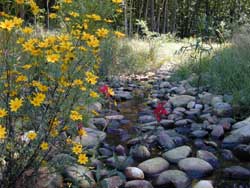The Northern Virginia Soil and Water Conservation District is a leader in pioneering and demonstrating innovative projects in Fairfax County. We facilitate partnerships to bring together government agencies, community groups, and the private sector to create cost-effective projects that protect soil and water resources. We follow up and test projects to capture and share lessons learned. We also bring these innovative ideas and practices to communities and homeowners with technical expertise, demonstration projects, do-it-yourself workshops and contractor training.
Green Infrastructure
The Soil and Water Conservation District has helped bring green infrastructure to the public eye in Fairfax County. We demonstrated how rain gardens, porous pavers, and green roofs can capture and absorb runoff and pollutants starting in the early 2000s. Since then, Fairfax County has adopted, implemented and now requires these practices.
The Soil and Water Conservation District has also pioneered use of green infrastructure for homeowners, providing technical recommendations, project guidance and financial support.
- A Rain Barrel Program began in 2006 with regional partners and has provided five thousand barrels to area residents.
- In 2008-09, a demonstration project in the Falls Hill neighborhood installed a rain garden, rain barrels, an infiltration trench, soil amendments and native plants to help trap and absorb runoff, serving as a model for other communities with similar problems.
- Since 2009, our Sustainable Garden Tour features homeowner-scale rain gardens, porous pavers, green roofs and more, inspiring hundreds of Fairfax County residents each year.
- In 2015, the Conservation Assistance Program was launched locally. The program now provides technical assistance and funds to implement green infrastructure at your home, in your community, and at your place of worship.
Stream Restoration: Natural Channel Design
Natural channel design stream restoration relies on the idea that the best way to protect a stream is to understand and restore its natural function. As Northern Virginia has been built up with more roads, roofs and other impervious surfaces, there is more runoff. When it rains, this water runs into storm drains and is discharged into our local creeks and streams. As a result, many Northern Virginia streams suffer from eroding stream channels, cutting steep banks and undermining tree roots. Natural channel design uses ecological and hydrologic principles to slow down water velocity using step pools, restore meanders, and reconnect the stream to its floodplain.
 In 1999, the Northern Virginia Soil and Water Conservation District brought the first natural channel design stream restoration to Fairfax County in Kingstowne through a partnership with Fairfax County, state and federal agencies, and two citizens groups. A second section of the Kingstowne stream was restored in fall 2011.
In 1999, the Northern Virginia Soil and Water Conservation District brought the first natural channel design stream restoration to Fairfax County in Kingstowne through a partnership with Fairfax County, state and federal agencies, and two citizens groups. A second section of the Kingstowne stream was restored in fall 2011.
Since then, natural channel design has been widely adopted by Fairfax County. Restoration helps create healthier stream corridors and reduces loads of harmful sediment and nutrient loads as part of the county's efforts to protect water quality downstream in the Potomac River and Chesapeake Bay.
In 2013-14, the Soil and Water Conservation District facilitated a stream restoration in Wakefield Park in Annandale, with a diverse partnership including Friends of Accotink Creek, Dominion Virginia Power, VDOT/Fluor 495 Express Lanes, Braddock District Supervisor, Fairfax County Stormwater Planning, Fairfax County Park Authority, Fairfax County Park Foundation, Fairfax Trails and Streams, Mid-Atlantic Off-Road Enthusiasts, and Earth Sangha. The effort engaged the community in naming the stream, facilitated plant rescues, and mitigated runoff coming from the new 495 Express Lanes.
The Soil and Water Conservation District has also been working to bring natural channel design concepts to smaller scale stream and channel projects. In 2007, a partnership with homeowners along Little Pimmit Run helped to restore the stream using natural channel design techniques, protect existing wastewater infrastructure, and prevent further erosion. In 2009, a project with a homeowner in Clifton, with a grant from Fairfax Water, was able to stabilize an eroding intermittent stream channel with step pools and other practices.
Erosion and Sediment Control
While anyone living in Northern Virginia has seen black fabric fences up around construction sites, many don't know that those silt fences actually exist to protect streams! Silt fences and other erosion and sediment controls help keep soil on site during construction, instead of washing off into the nearest storm drain and into our streams and rivers.
Before there was green infrastructure or natural channel design, the Northern Virginia Soil and Water Conservation District helped lead the effort to promote erosion and sediment controls, which were requirements on construction sites beginning in the 1980s. These controls remain vitally important today, in conjunction with more innovative green infrastructure stormwater management practices. Poorly implemented or absent controls can lead to significant sediment load downstream.
To promote well-implemented erosion and sediment controls, the Soil and Water Conservation District partners with the Fairfax County Department of Public Works and Environmental Services each year on the Land Conservation Awards.

